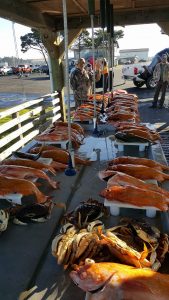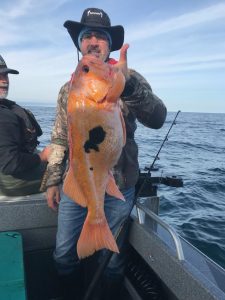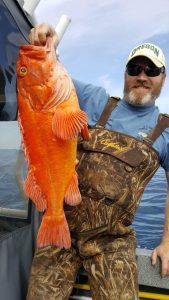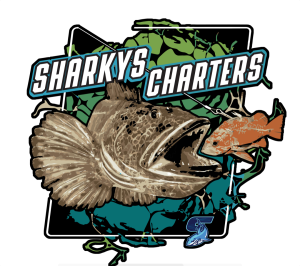Welcome to the future of fishing folks! Lets make it really hard for anglers to catch a fish without bait, really deep, with a float, 30 foot long-leader to lead, and a three hooks. If that wasn’t hard enough, make sure you download the 40 fathom curve onto your chart plotter and don’t be caught inside of it fishing with a list of other species on board! All joking aside, and jabs at the Oregon Department of Fish and Wildlife (ODFW) the long-leader rockfish fishery happens to be a totally awesome experience that you don’t want to miss out on. I would personally like to thank Wayne Butler of Prowler Charters in Bandon, Oregon for helping to create this fishery with O.D.F.W. Without you Wayne my winter would have been a complete bust. So finally after many years of effort O.D.F.W has added a new fishery for offshore anglers to experiment with called the “Long-leader” rockfish fishery for 2017, and we hope its approved for 2018 by the Pacific Fisheries Management Council in March. If you get out there and give it a try you may be pleasantly surprised like I was with limits of huge rockfish!

On this trip I had five anglers, and with a bag of 10 rockfish each, we brought home 50 fish. Most of the fish that day were Canary rockfish with a handful of Yellowtail rockfish. These fish are about twice the size of fish that you will catch in the nearshore. I found the average weight and size of the Canary and Yellowtail rockfish, which are numerous, to be around 5 lbs. The Widow rockfish are also part of the catch but much smaller in size. They are none the less a tasty rockfish. I must mention that the deep water long-leader rockfish are some of the better eating fish in the ocean when bled properly and cared for. The meat is white and firm. Best used for fish and chips or traditional fish tacos however anyway you cook it just not over cooked will produce a mild and flaky meal.

So then,”How do you go about catching them?” Good question. The three things I will cover are location,gear, and technique. Rockfish like structure and off the coast of Oregon that structure is rocky reefs. The reef structure disrupts and focuses currents in the area surrounding the reefs, and there by concentrates the fishes food. The fish congregate in these areas for an easy meal. With that said I will add the caveat that I sometimes find the Canary rockfish off on the flats around the reef. It just all depends on what they are feeding on and the currents. When you find the reef dont just fish structure use your depth sounder to locate the feed first which looks like a cloud on your sounder off the bottom and then pay attention to the marks below that cloud of feed. Since we are fishing in such deep water it can be difficult to determine what is fish and what isnt. The best way is to use your crew as the fish finders. Drop a line into likely looking ” clouds” and see what they get. If they don’t get bit in the first few minutes I will usually try and reposition. The Canary rockfish seem to prefer areas on the reef where there is a steep drop off or shelf. The best fishing I have seen so far was in December on one of the shelf drop offs. The shelf dropped nearly 30 feet vertically, and by positioning the boat up-current so that I would drift to the edge of this shelf with the gear yielded multiple hook ups per drift. Once past the shelf I would have the anglers reel up and we would drift it again. To find these reefs outside the 40 fathom curve (240′) can be difficult the ocean is a big place and usually these reefs are far offshore. If you don’t have a source for “numbers” I recommend a visit to a local mom and pop type tackle store. Buy some gear and then ask for directions to a know reef. Do it in that order and I am sure that you will get results.Out of Coos Bay we have reefs outside the 40 fathom curve both to the North and South of the port. The Tenmile Reef to the North approximately well ten miles north west and Cape Arago reef to the southwest about the same distance. I cant give you exact numbers or my shop would get burnt down by locals! Do your research and it wont be any problem. The gear that I use includes the following materials 2 oz. non-compressible float, 100# jinki and corresponding jinki line crimps for making the dropper leader, 6/0 octopus hooks or shrimp flies, large stainless barrel swivels for the ends of the dropper leader, 60# Oregon green fiber long-line ganion for the 30′ dropper, 40# monofiliment for the break away, and 1#-3# tombstone lead weights. This basically gives you the materials you need to build a shrimp fly rig w/float, a 30 foot dropper, and a break away for the lead. I know this rig seems very heavily built for a five pound fish, but I do it for a reason. Tangles and twist are much easier to control and undo with the heavy leader. The fish don’t care if its heavy and bite it. No need for fluorocarbon in this fishery! I do recommend using scent products on your shrimp flies it will make a huge difference and if in the future we can use bait I recommend squid or octopus. One alternative to try is Berkeley Gulp products. They are artificial baits but smell near the real thing. I will attach a picture of this later or a link to video in how to build this. Alright lets talk about technique. Mid-water rockfish which include Canary, Yellowtail,and Widow rockfish are susceptible to this long-leader method because they live up off the bottom for the most part feeding. What I like to do is have my clients hit the bottom with the lead and then reel up a few turns so that the lead no longer touches the bottom as the swell rises and falls. This does two things it keeps me from snagging and losing my 10$ lead and it puts the lure away from Yelloweye rockfish which we want to avoid. The one in this photo was immediately descended back to depth after a quick photo. Yelloweye rockfish are a prohibited and threatened species and must be released with a descending device.

Once the angler is up off the bottom I have them start to slowly reel the rig up for 10 to 20 turns of the reel handle. If the fish are there this will get you bit. If a bite doesn’t happen I will have them drop and repeat it. My patience for not catching is limited so I end up moving the boat if we are not catching. A descending device is required by O.D.F.W to be with you on long-leader trips and you must use it on any rockfish that is going to be released. You can make your own or buy one from a tackle store. Essentially it holds the fish as it is descended back to depth and re-compressed. The fish when brought up from depth cant relive the gases that build up, much like they do in a human diver, and the fish gets the bends. If you were to just throw this fish overboard it would most likely just float and be unable to swim back to depth. A fishing pole just rigged for this purpose with a heavy 5#lead and the descending device is helpful. These Yelloweye rockfish can be huge and a heavy lead is needed.We use mostly electric reels and heavy rods in this fishery so releasing these fish at depth is relatively easy. I fully recommend a electric reel and heavy rod for this fishery. It allows for quick retrieves, keeps you from getting fatigued, and you can use heavy leads which keep your lines more vertical when fishing deep and the drift may be strong. Drift is also something that I want to mention. When you are fishing out deep the currents around these reefs tend to be strong. Using heavy gear will help you over come this drift and sometimes even backing the boat at an idle into the drift is necessary. Keep the gear vertical as possible. It will help prevent snag ups and you will catch better! So with that I wish you good luck and visit and like my page at Sharky’s Charter Fishing on Facebook to see more photos and get fishing reports. See you on the water.
